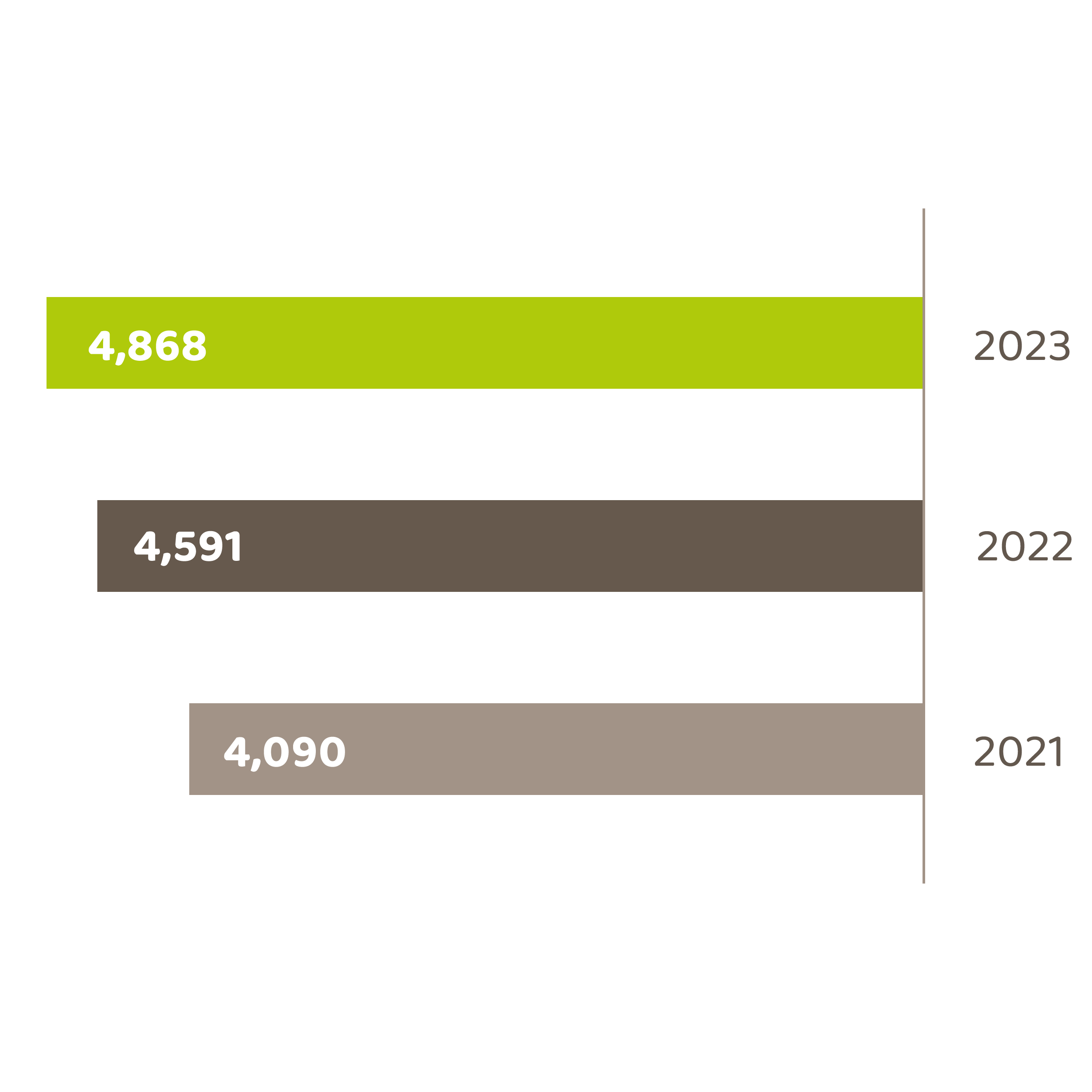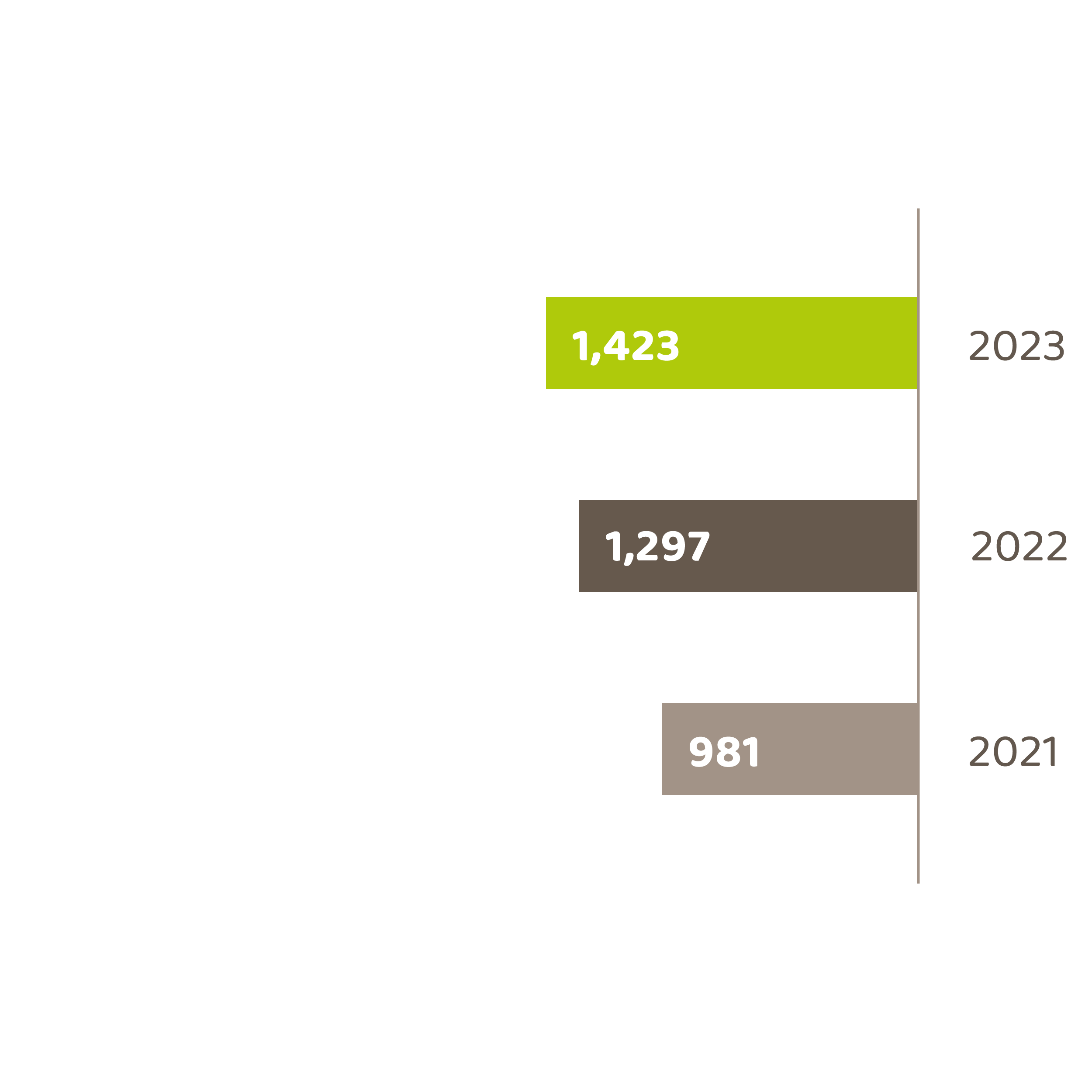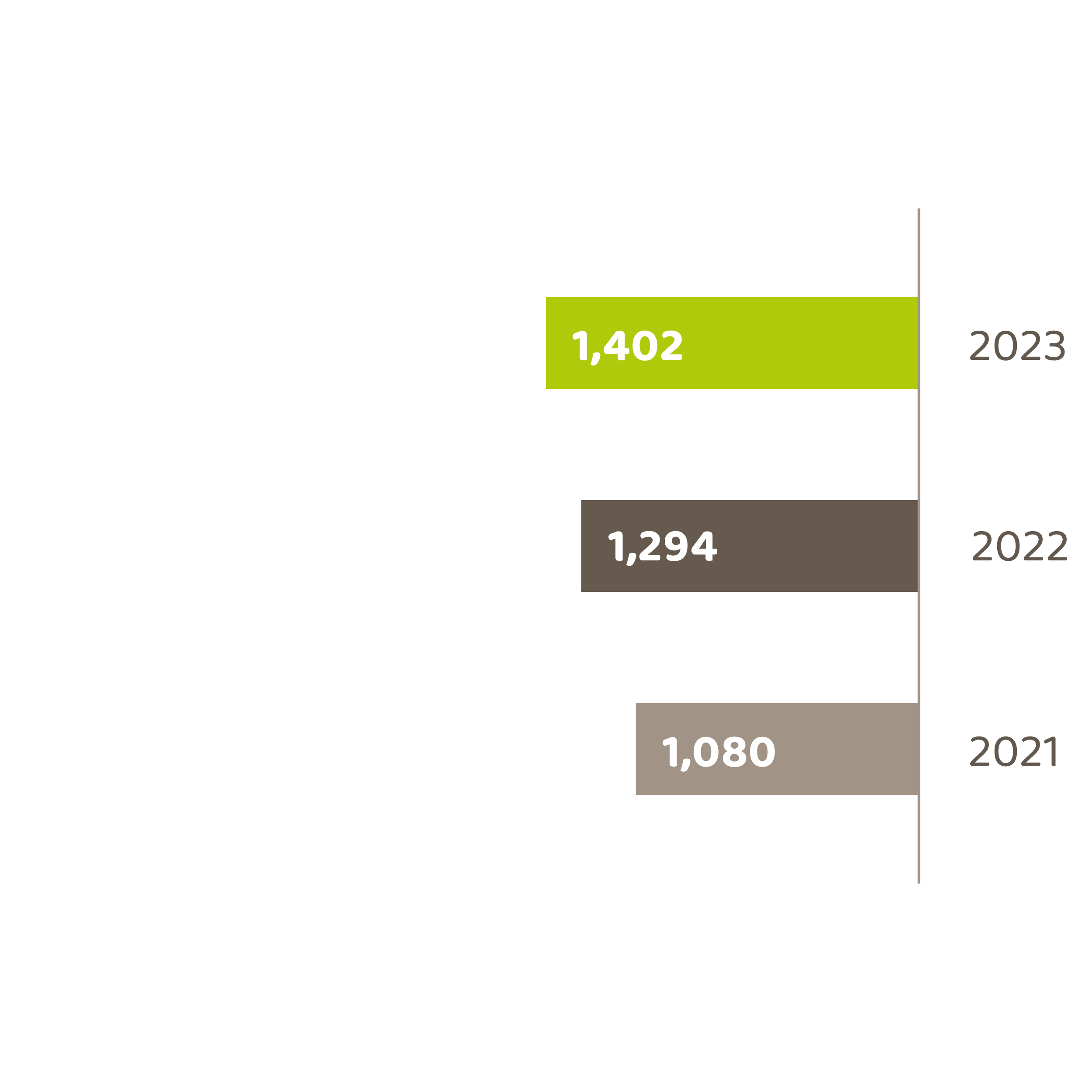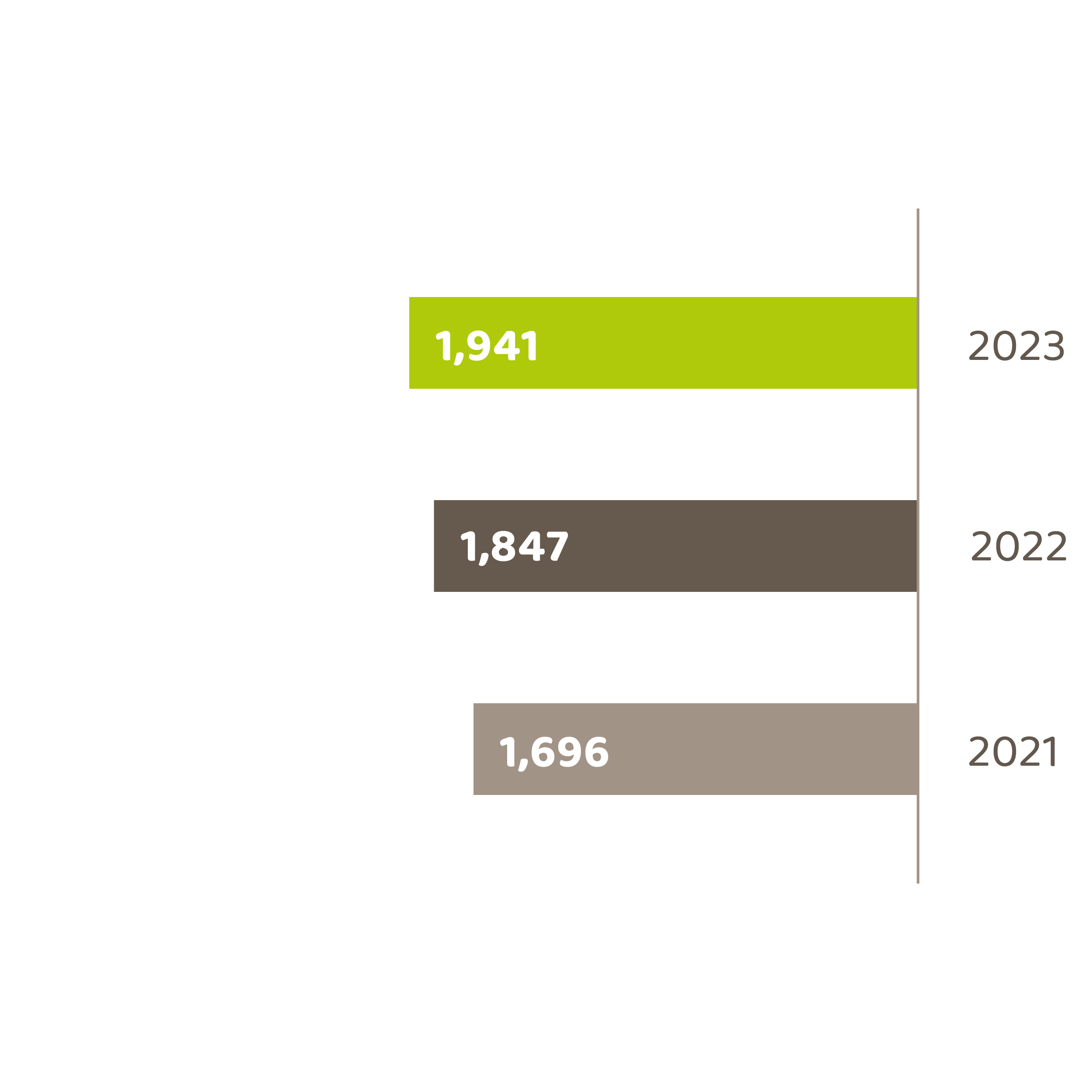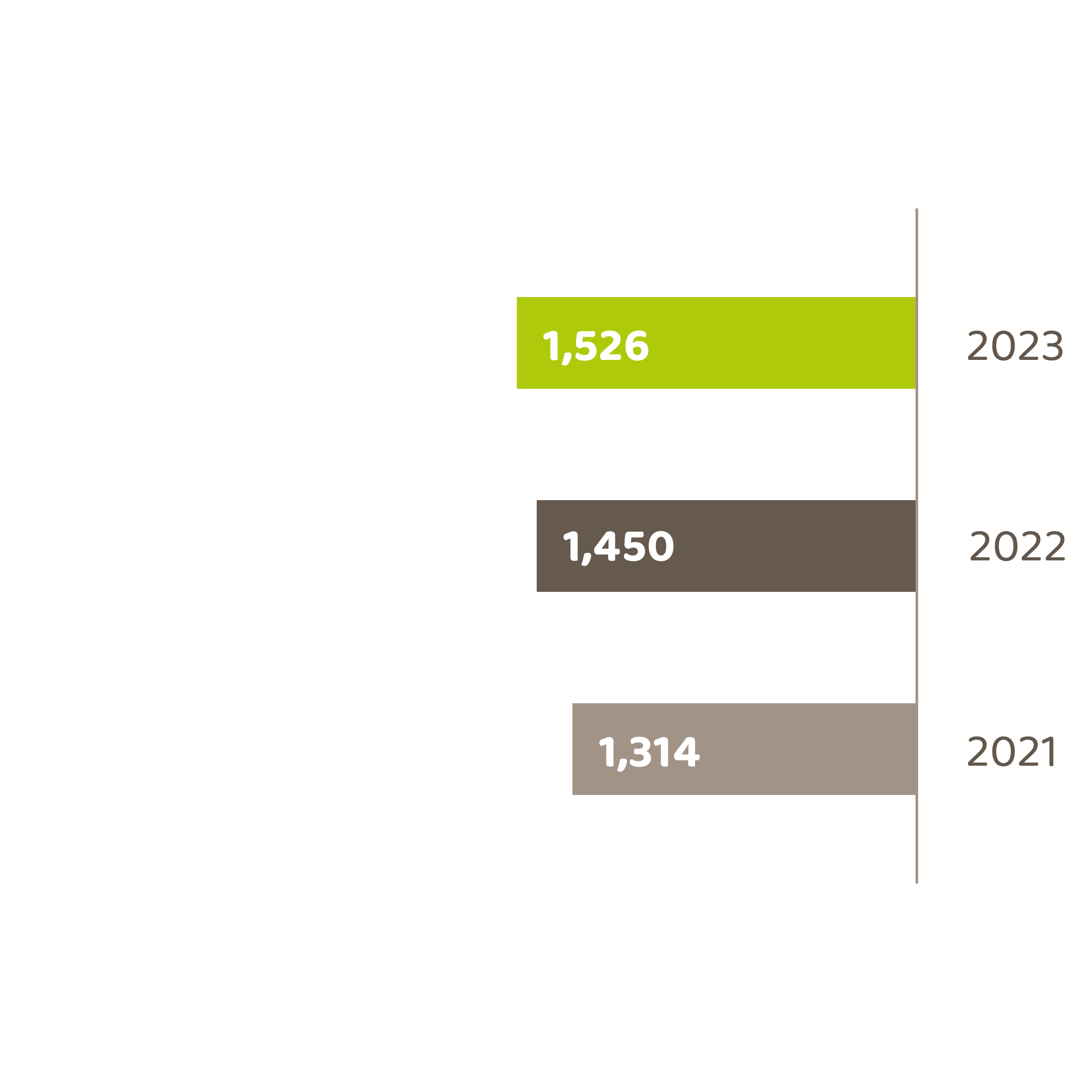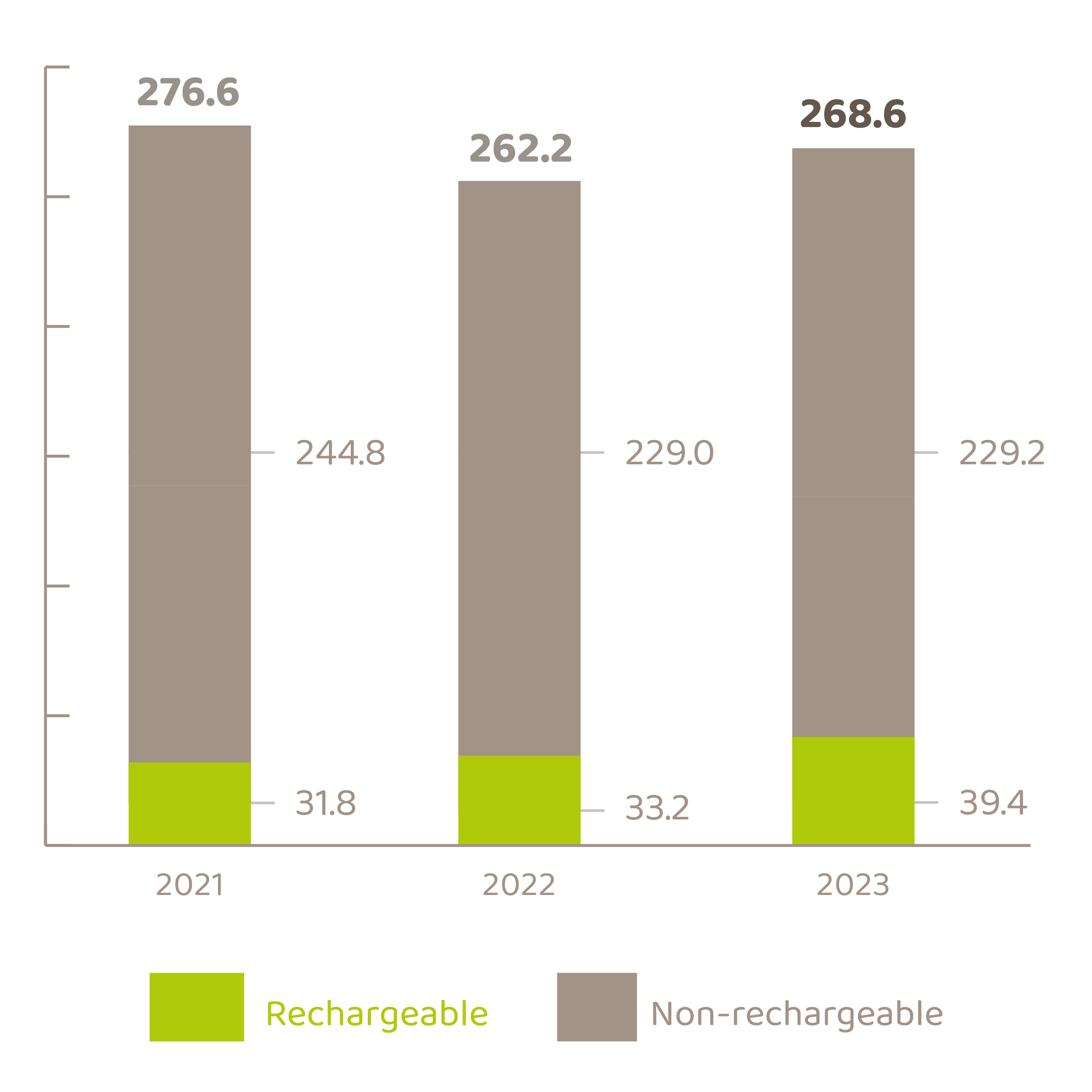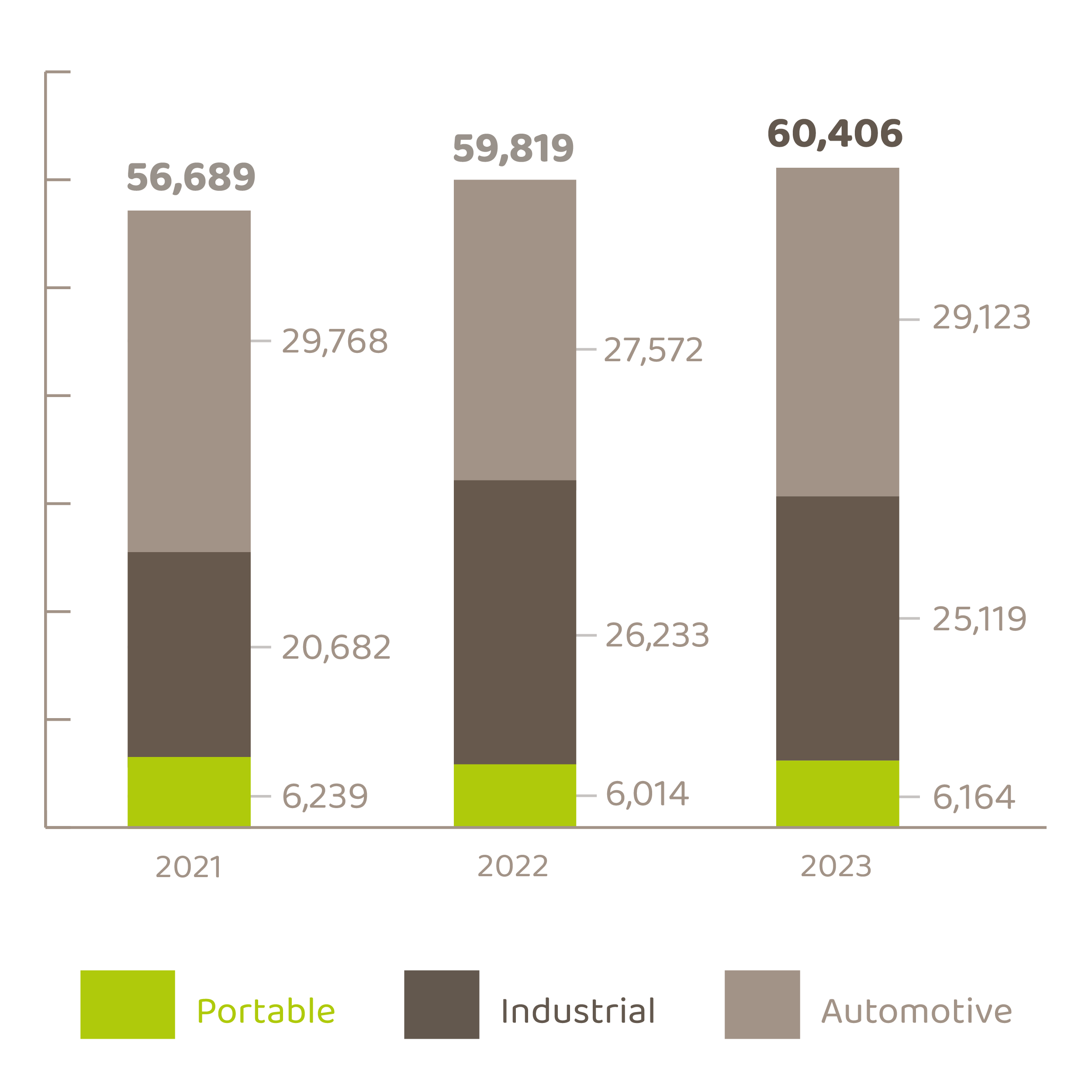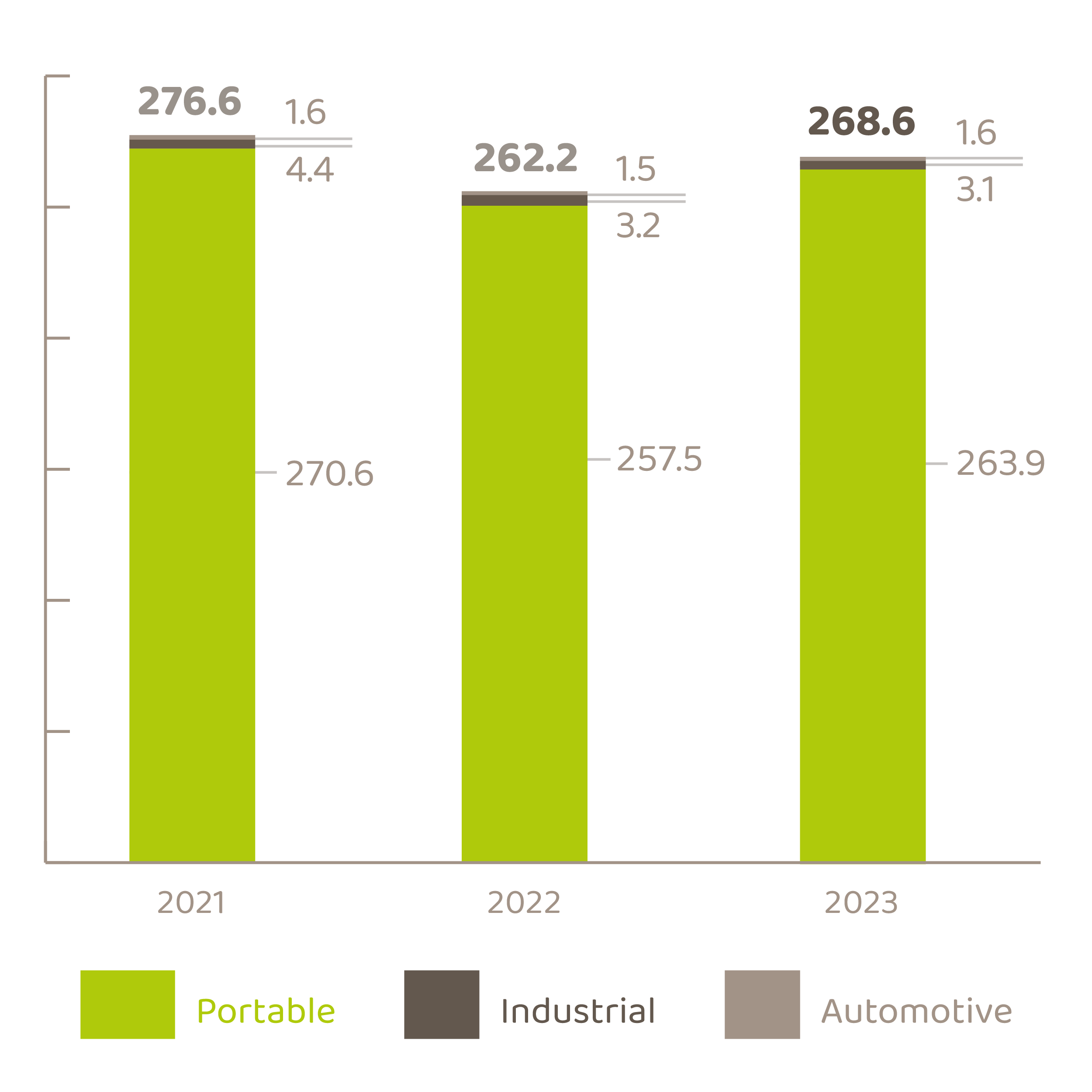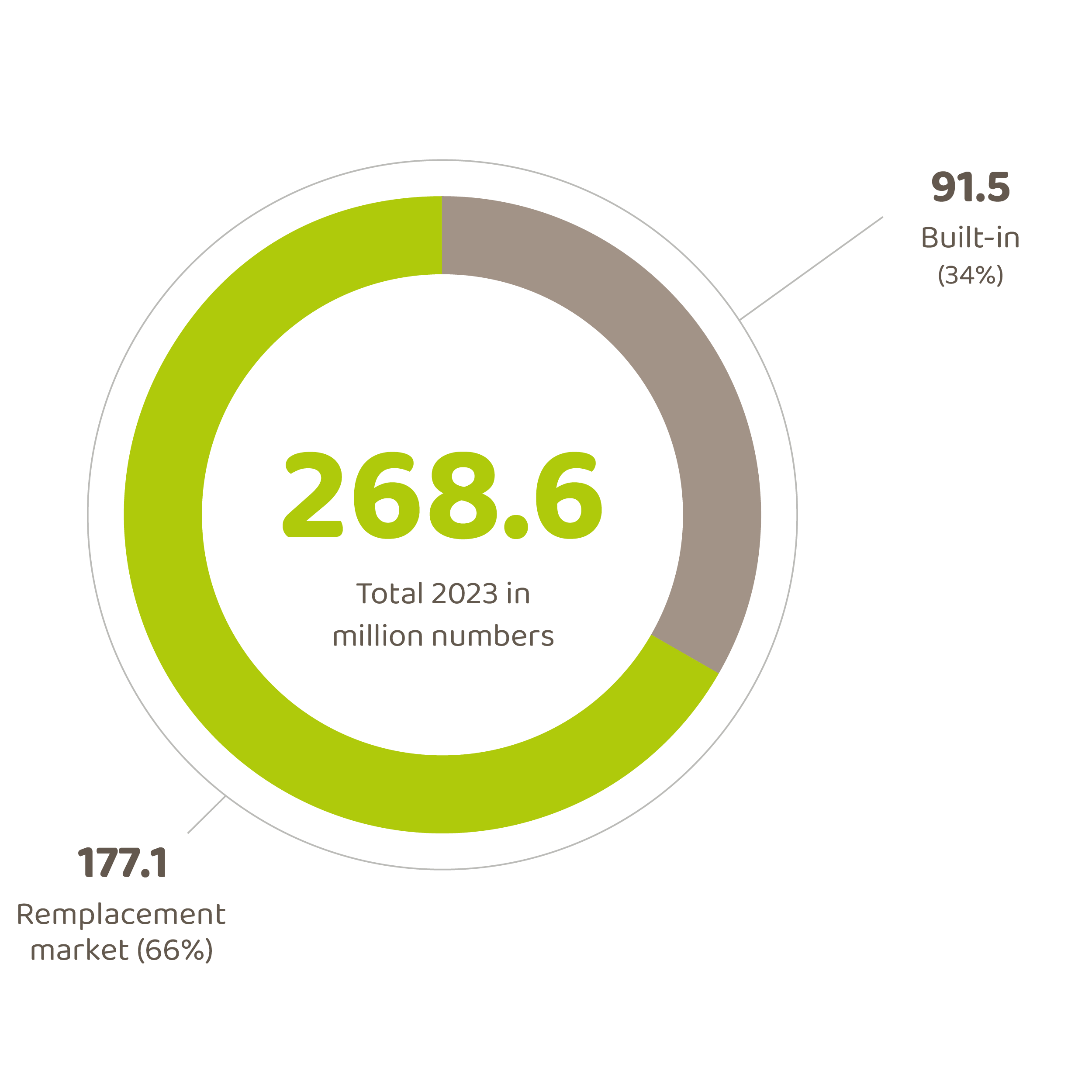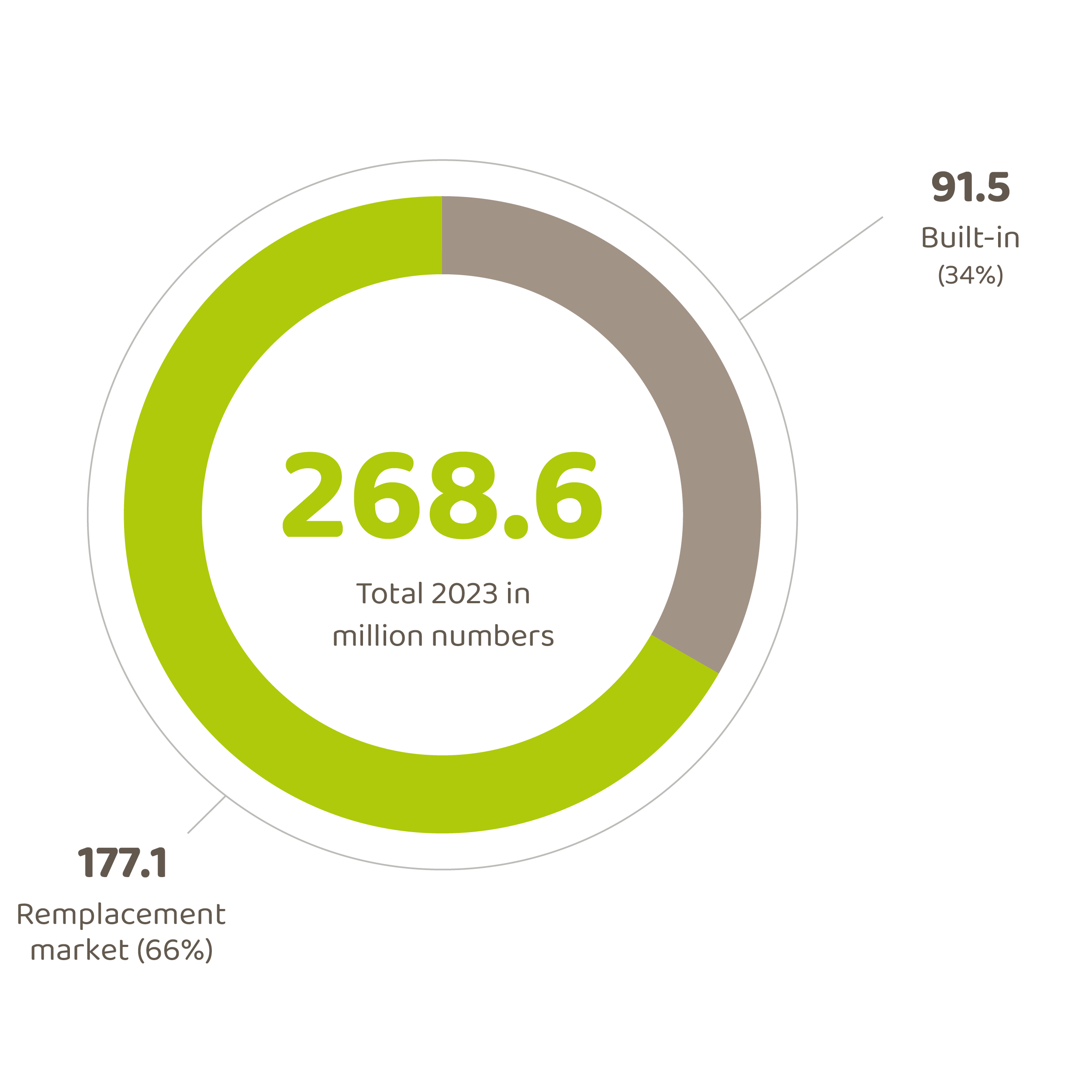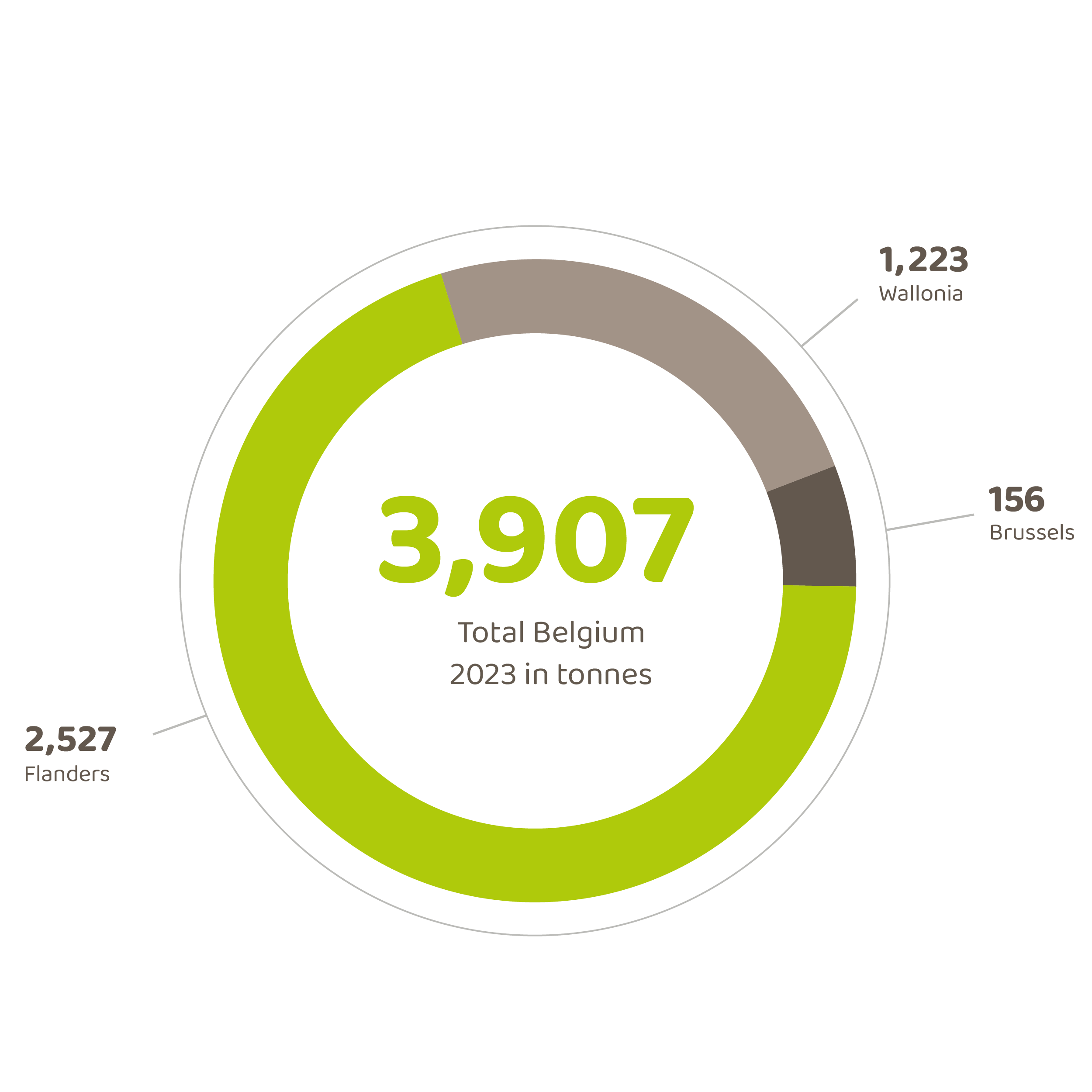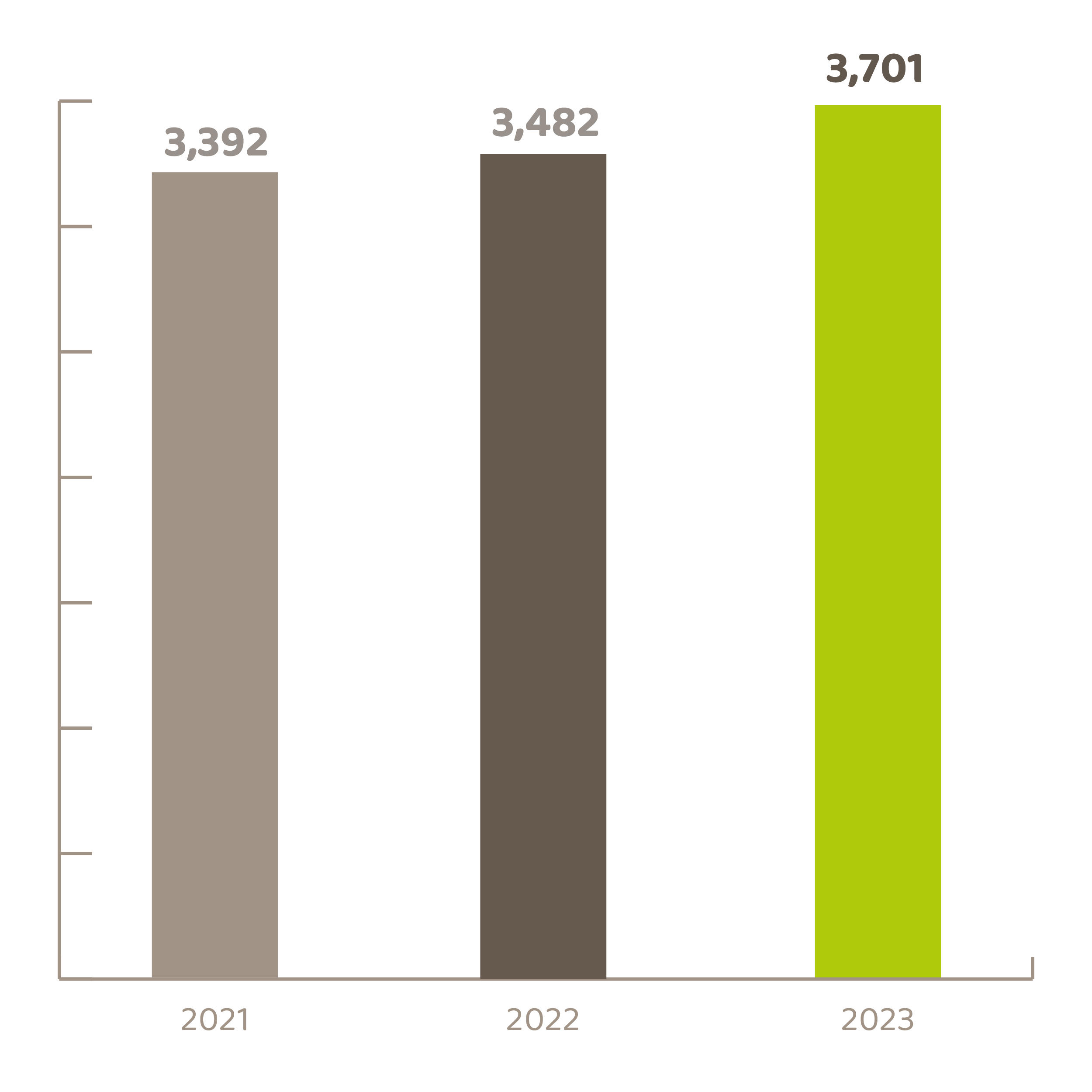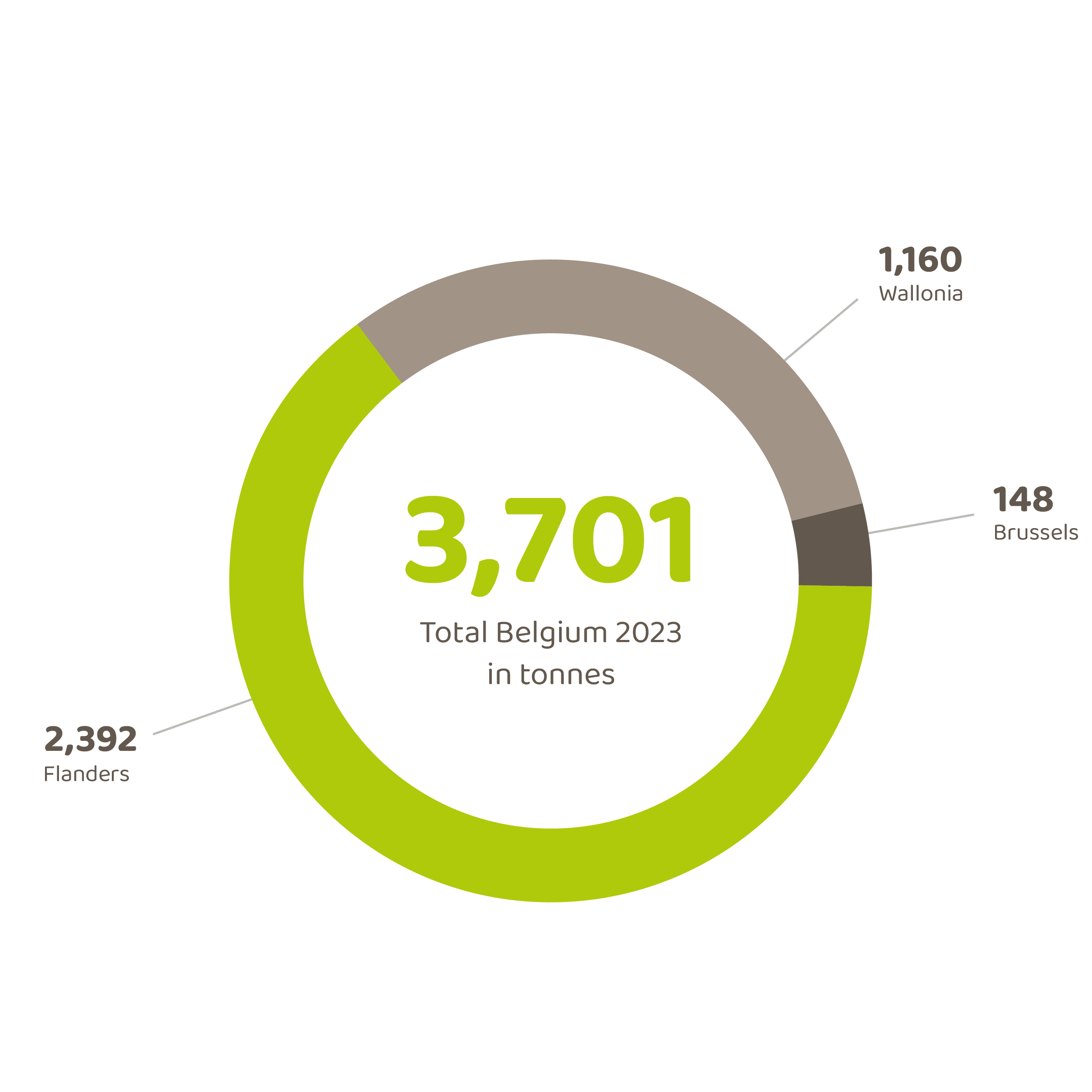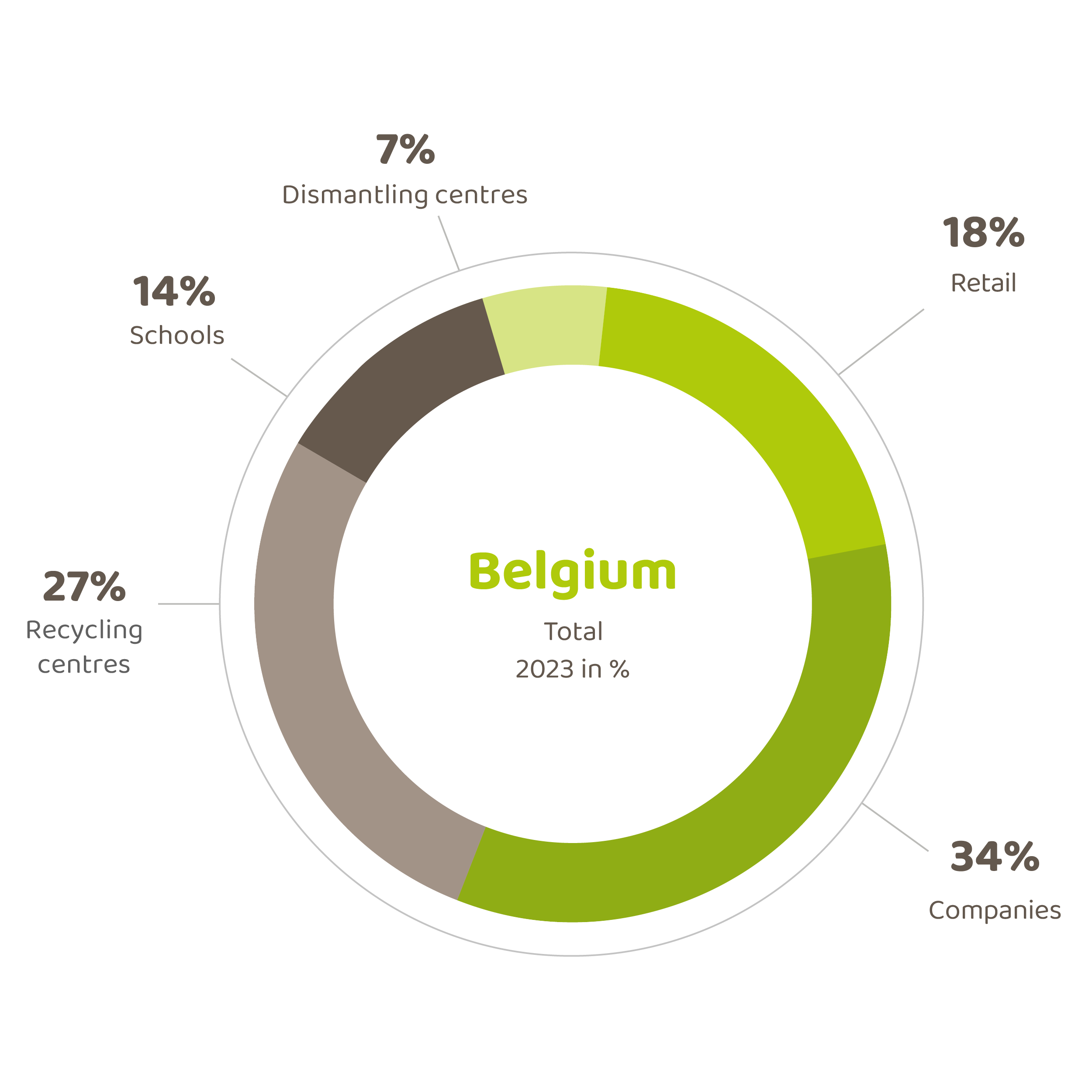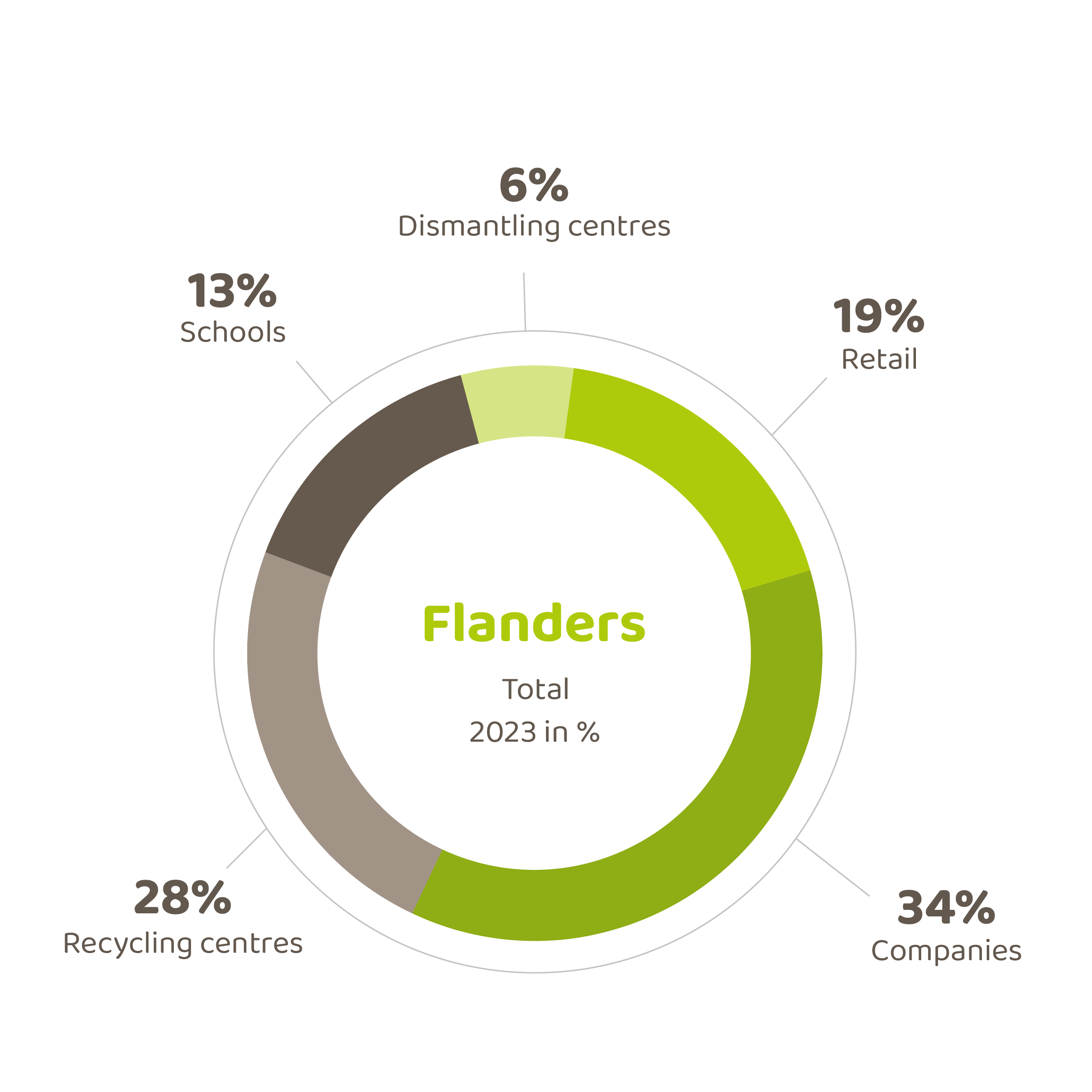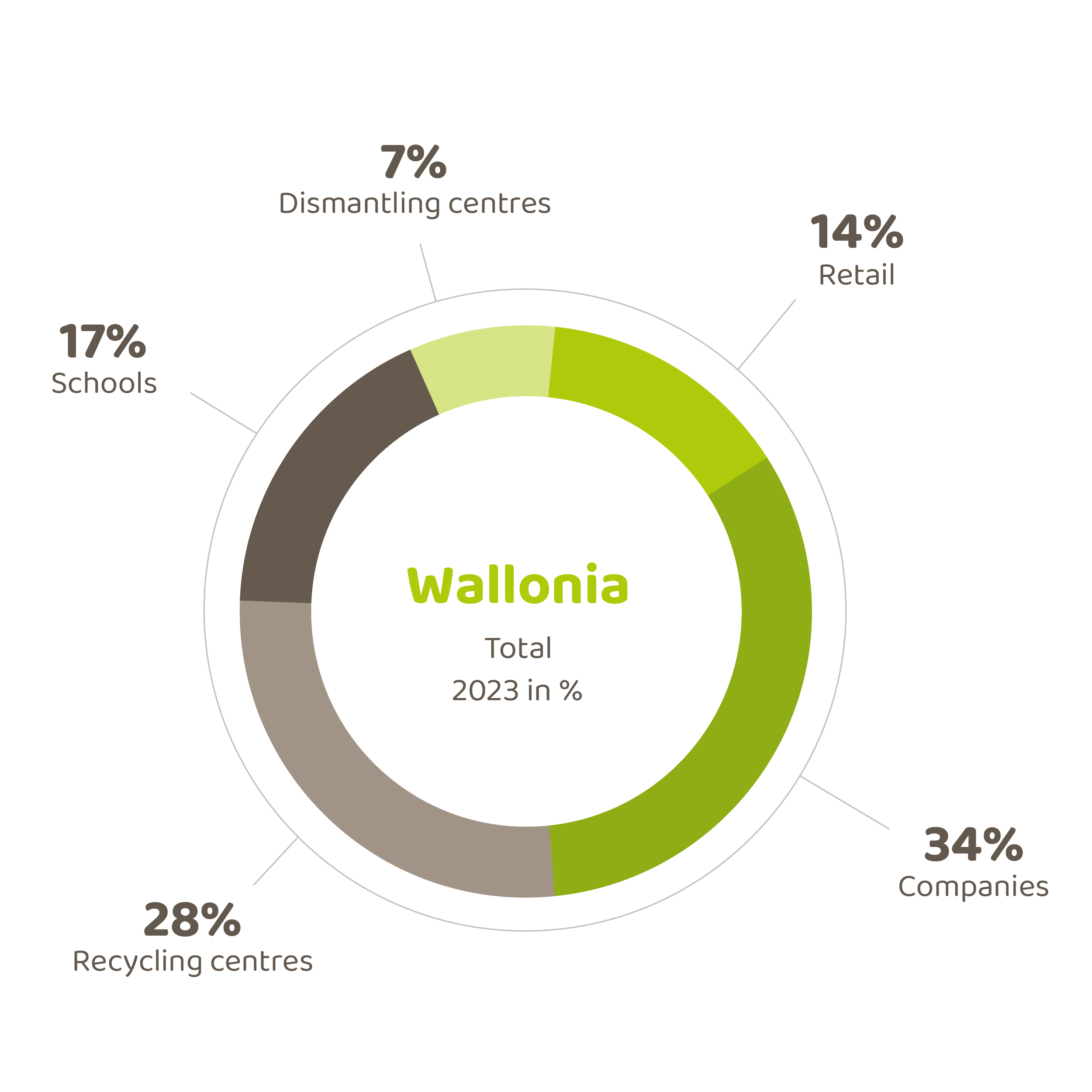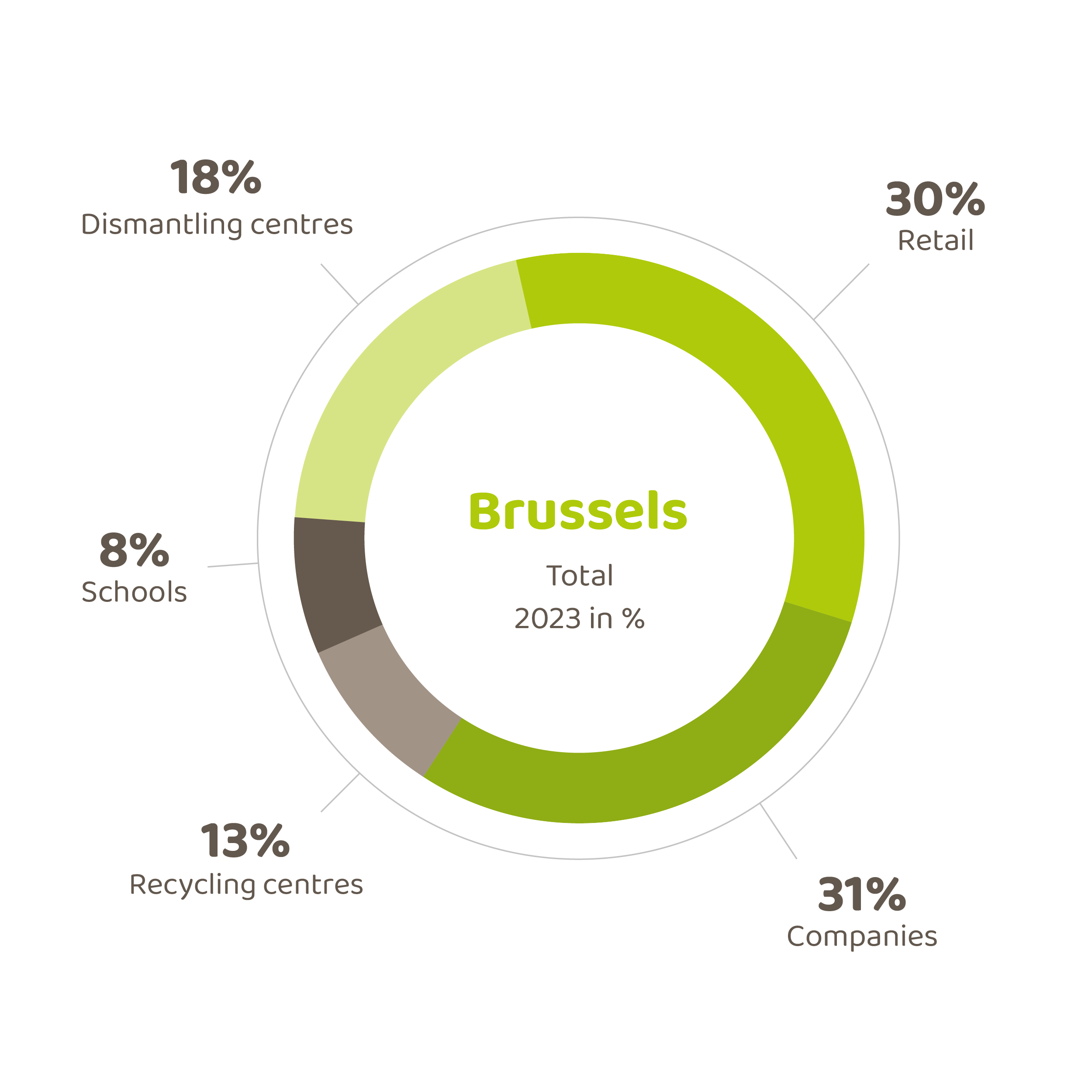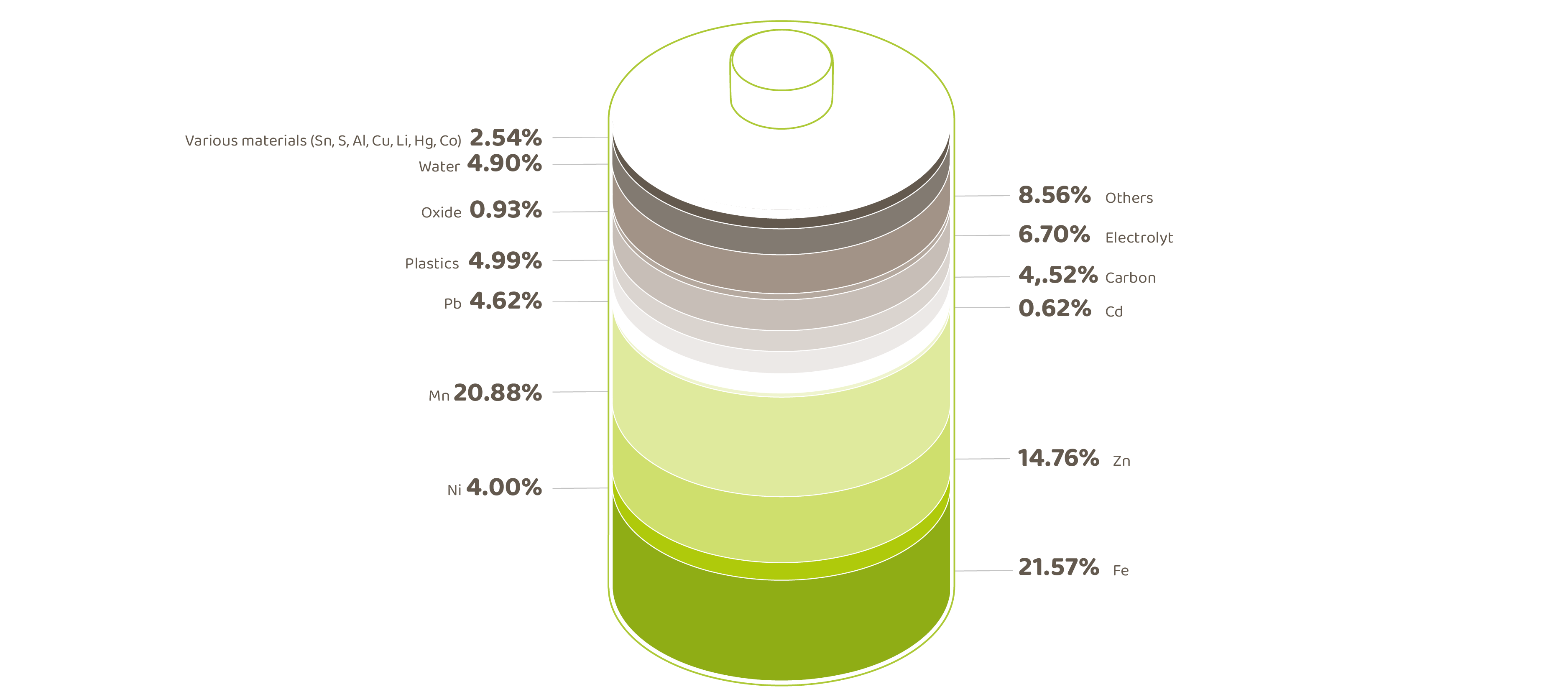Annual report 2023
Download PDF
Working together towards a brighter future
Recycling together, better for all of us
Our new baseline says it all: recycling batteries is not only better for nature, but for all of us. Thanks to our national campaign – with a new battery icon – we have managed to focus on all batteries, visible or non-visible, as we want to collect and recycle all of them.
Collection results to be proud of
Thanks to everyone’s efforts, we are proud to have collected 3,907 tonnes of used batteries in 2023: an increase of 5% as compared to 2022. A lot of schools participated in our successful campaigns, which included a chance to win recycled benches and playground furniture made from our own waste plastic collection barrels. Together we made more than 100 playgrounds in Belgium more sustainable.
Creating awareness
Our efforts have raised awareness about battery collection. A good mesure is the number of participants to our system: over a period of 10 years, their number has tripled to 4,868 participants. This increase also highlights how fast the battery sector is evolving.
European legislation
Thanks to our efficient collection system, we achieved a collection rate of 60.3% in 2023. Belgium is already the country closest to the EU target for 2027 (63%), which makes us confident that we can meet this future collection target. However, the European collection target for 2030 of 73% is not realistic, according to Bebat. This is because the calculation method does not consider the longer lifecycle of lithium-ion batteries that are now entering the market in vast numbers. Nor does it consider that these batteries are often built into appliances and exported or reused. Together with compliance organisations in other member states, Bebat is working on a calculation method based on the real life of these batteries – which is much longer. Only then will the European collection target accurately reflect the changing battery market.
Ready for the future
As the collection channels for lithium-ion batteries can be very different from traditional ones, we will continue to push for innovation and creativity to increase the collection and recycling of these batteries in 2024. We also continue to innovate and carry out pioneering work elsewhere. In the coming years, for instance, we will use AI to sort batteries, for optimal recognition and recycling of the important raw materials. We will continue to improve and expand our smart collection drums and will go live with our new software mid-2024; this will help collection points and participants interact more easily with Bebat.
We are incredibly proud of what Bebat achieved in 2023 and look forward with confidence to the challenges the future holds.
Peter Coonen
Managing Director

Yves Van Doren
Chairman of the Board of Directors

Mission
At Bebat we work for a better environment by collecting ever more used batteries and recycling them ever better.
We make the collection and recycling process as easy, safe and efficient as possible.
We stimulate sustainable use, collection and recycling through a wide-ranging and transparent communication strategy.
Organisation
Bebat is a non-profit organisation (NPO) established in 1995 by the battery manufacturers to enable companies to meet the take-back obligation.
Bebat gives a new life to used batteries and ranks among the world leaders in the collection of used batteries. At our more than 24,000 collection points, used batteries can be handed in easily and free of charge. Bebat organises their collection as well as the sorting and recycling process.
The Bebat management board is formed by representatives of the following companies, organisations and government authorities:
What does Bebat do for its participants?
Participants
Total number of participants
Number of participants with an annual declaration
Number of participants with a monthly declaration
Number of participants to bring separate batteries onto the market
Number of participants to only bring batteries onto the market that are insalled in a device
Number of participants to bring onto the market both separate batteries and batteries installed in a device

Audits
Bebat helps participants meet all legal obligations. We try to make the process as simple as possible and to communicate in a transparent manner.
The audits are key in ensuring that all participants make a fair contribution to the Bebat system. Participants are audited at least once every 3 years.
Batteries put on the market
* Note: when using the figures: the figures are sometimes rounded to the unit. This may cause discrepancies between the totals displayed and the sum of the individual digits.
Rechargeable versus non-rechargeable
Portable - Industrial - Automotive
Built-in versus replacement market
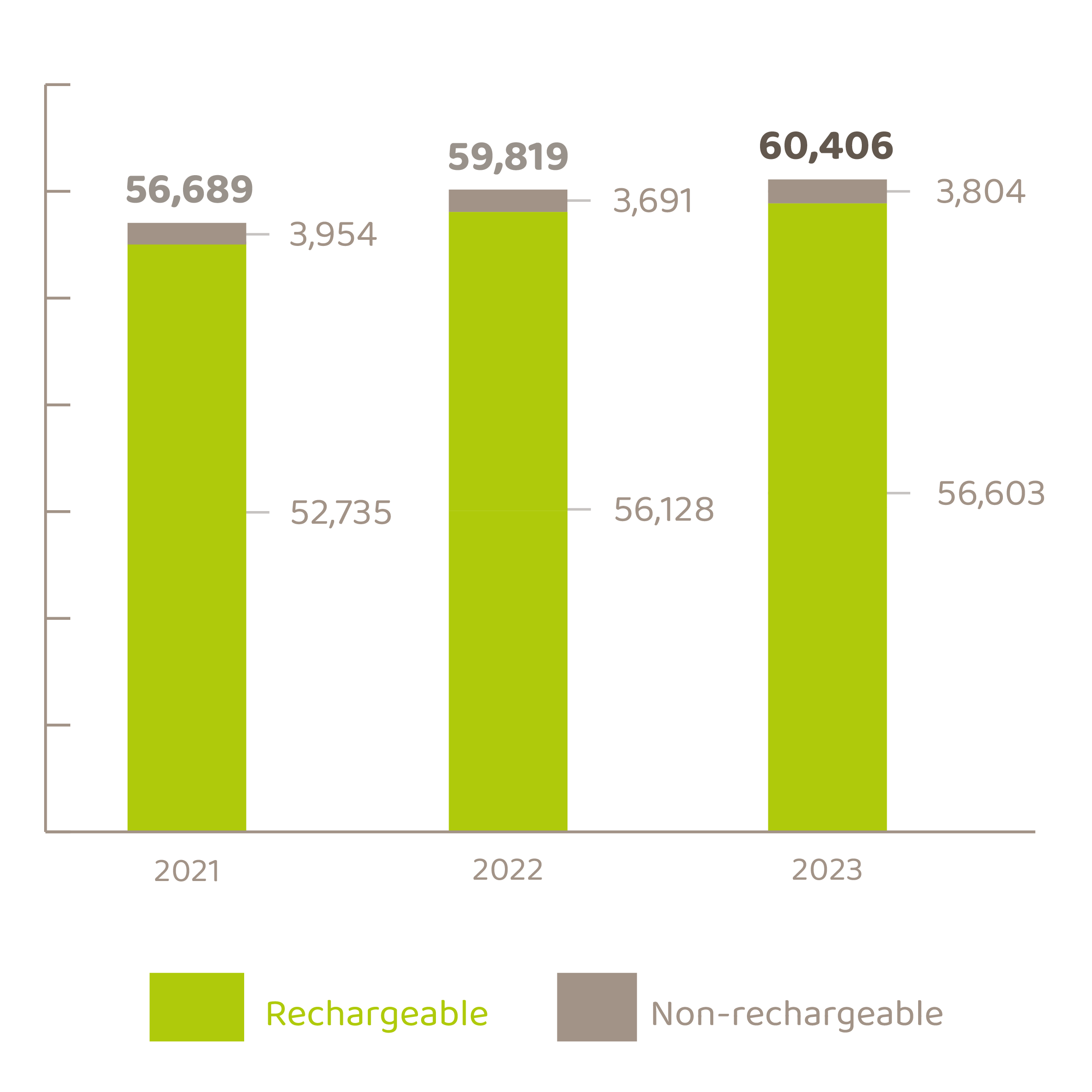
* Note: when using the figures: the figures are sometimes rounded to the unit. This may cause discrepancies between the totals displayed and the sum of the individual digits.
Conclusion
In 2023, the number of batteries put on the market was 268,591,166 units. This is an increase of 6,420,569 batteries (+2%) compared to 2022. This increase was primarily caused by an increase in lithium rechargeable (+36%), lead (+4) and alkaline (+2%), but was weakened by a decrease in nickel-cadmium (-16%), zinc-carbon (-14%) and nickel hydride (-9%).
In 2023, 60,406 tonnes of batteries were put on the market. The total weight put on the market in 2023 has increased by 587 tonnes compared to 2022. This corresponds to an increase of 1%. This increase is due to the rise in sales of general rechargeable and primary batteries.
Within non-rechargeable batteries, there is a drop in zinc-carbon (-16%) and silver oxide (-7%) batteries. Alkaline, zinc-air and primary lithium batteries increase by 6%, 82% and 8% respectively. For general rechargeable batteries, we notice an increase in the weight of nickel-cadmium (+497%), nickel-metal hydride (+178%), lithium rechargeable batteries (+2%) and lead batteries (+6%).
There was a decrease in the weight of propulsion car batteries (-48%) on the market compared to 2022. Finally, there was a 10% decrease in the weight of bicycle batteries put on the market and a 24% increase in the weight of ESS batteries put on the market.
The weight of portable batteries put on the market increases by 150 tonnes or 2%. The largest absolute increases are for alkaline batteries, general lithium rechargeable, lead and lithium primary batteries.
The weight of industrial batteries decreased by 1,114 tonnes, or 4%, compared to 2022. The weight of automotive batteries increased by 1,552 tonnes, or 6%, compared to 2022.
Collection results
* Note: when using the figures: the figures are sometimes rounded to the unit. This may cause discrepancies between the totals displayed and the sum of the individual digits.
Total collection result in terms of weight (in tonnes)
Collection results portable batteries in terms of weight (in tonnes)
Overall collection results per collection channel (in %)
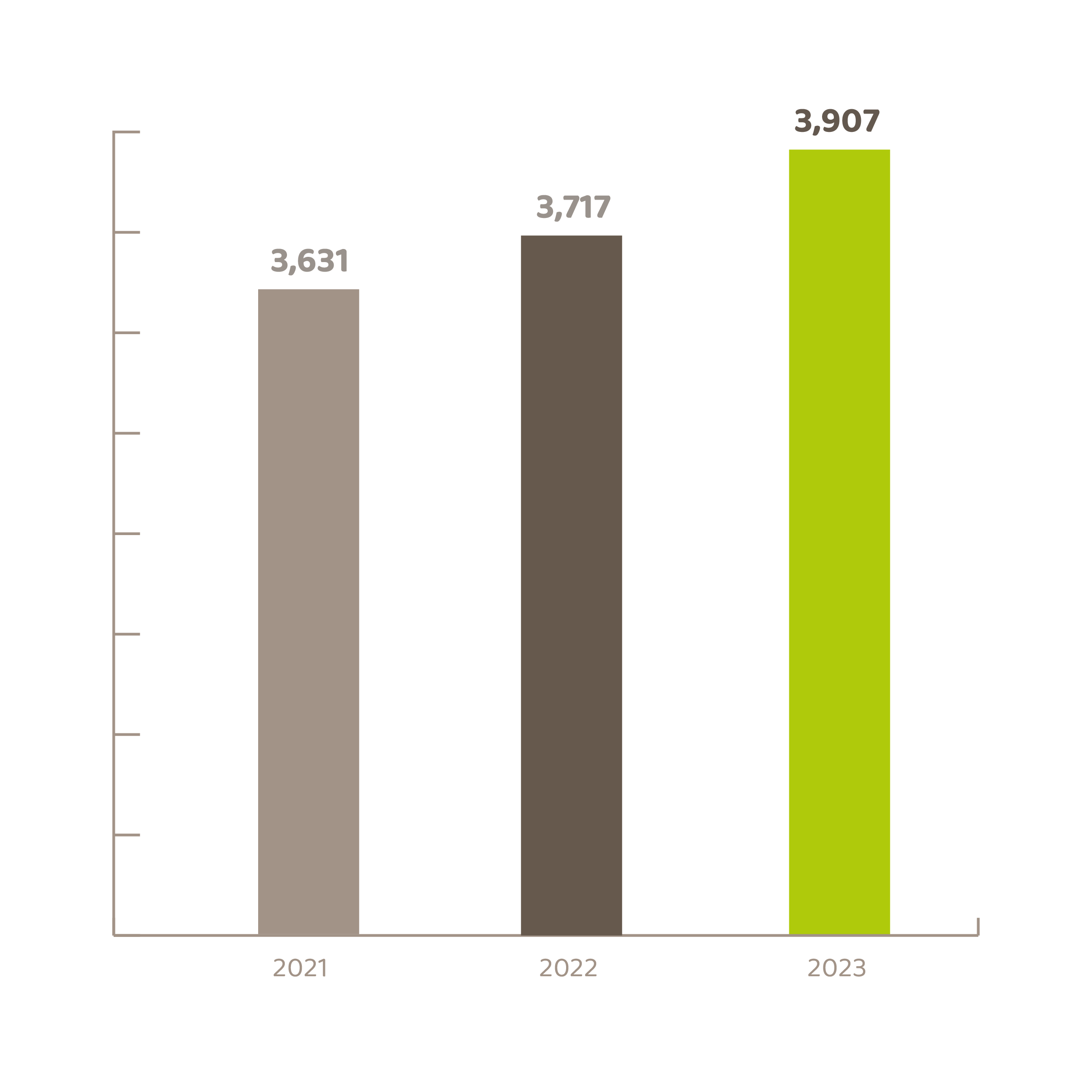
* Note: when using the figures: the figures are sometimes rounded to the unit. This may cause discrepancies between the totals displayed and the sum of the individual digits.
Overall collection results per collection channel (in %)
In 2023, the total of batteries collected in Belgium increased by 5%, or 190 tonnes.
This is mainly due to increased collection in schools. The 5% increase in 2023 for all regions combined across channels is in line with the efforts and initiatives we kept undertaking throughout 2023 to maximise collection rates.
In Flanders, companies continued to be the most important collection channel (34%), followed by recycling centres (28%) and retailers (19%). In Wallonia, companies (34%), recycling centres (28%) and schools (17%) were also major collectors in 2023. In Brussels, the primary collection channels were companies (31%), retail (30%) and dismantling centres (18%).
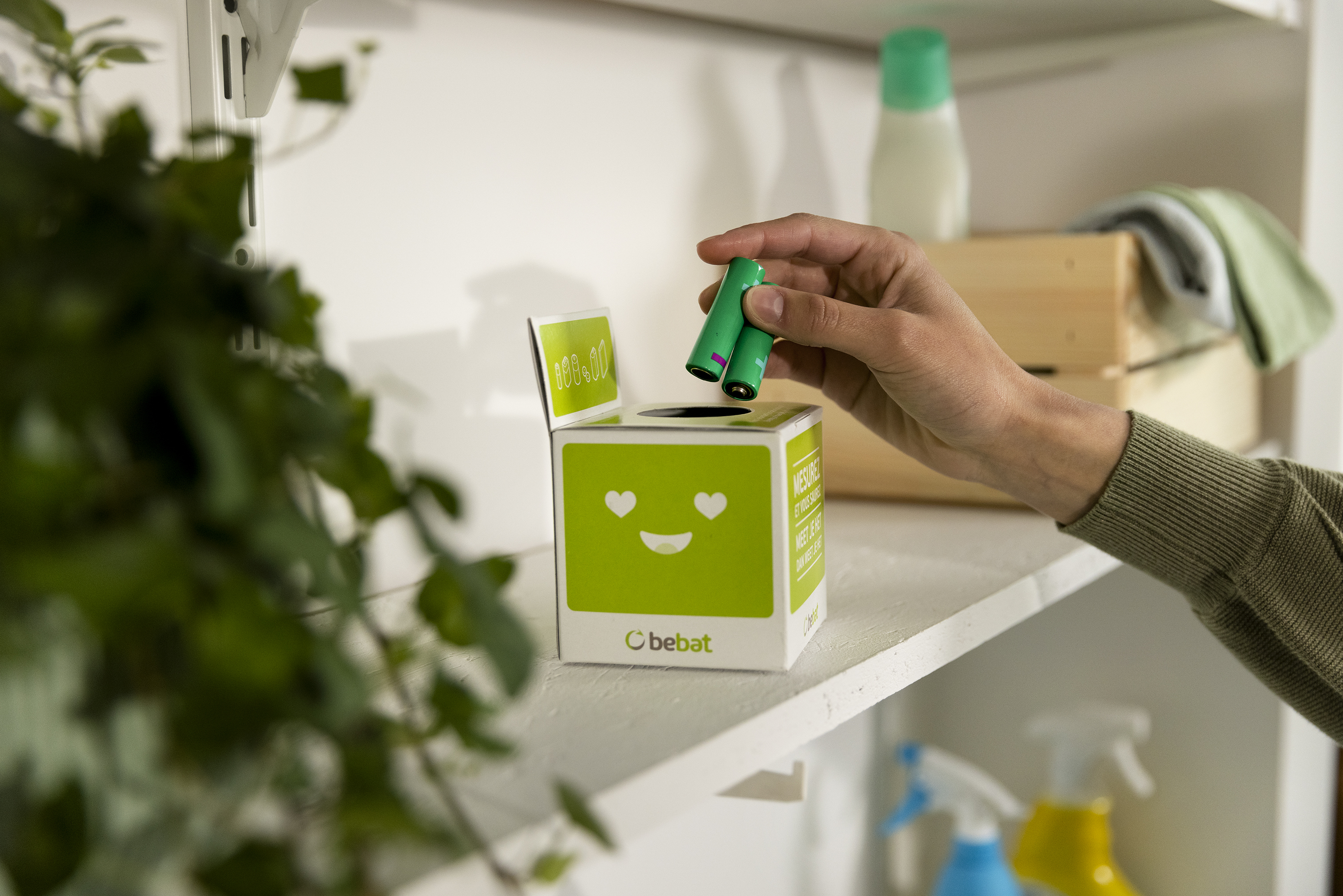
Collection rate
60.3%
Collection rate 2023 Belgium
According to the official calculation method used in Belgium, the collection rate achieved by Bebat in 2023 is 60.3%. However, this absolutely does not mean that the remaining 39.7% of batteries ends up in the environment.
This is primarily due to the increase in the quantity of collected portable batteries, which amounted to 186 tonnes. In recent years, we have noted significant growth in lithium rechargeable batteries put on market. These have a much longer life span than the reference period of three years used to calculate the collection rate. Bebat expects that the weight of rechargeable lithium batteries will continue to significantly increase even more in the coming years. It is clear that the current method of calculating the collection rate is no longer adequate and that the introduction of a collection rate calculation methodology based on what is available for collection is absolutely necessary.
With a collection rate of 60.3%, Bebat easily meets the statutory target for Belgium and exceeds the European target of 45% for 2023. Thanks to these results, Bebat retains its top rankings, both in Europe and in the rest of the world.
>90%
Percentage recycling efficiency
As the legal calculation method does not paint a realistic picture of the actual collection efficiency, Bebat frequently has household waste streams tested for the presence of batteries.
Several studies have shown household waste to contain just 1 battery per 100 kg of waste. This means that Bebat collects more than 90% of the batteries that consumers want to dispose of.
12,400,000
Number of consumer movements
Appliances are becoming increasingly smaller, resulting in increasingly lighter batteries and a continuously lower average weight of the batteries collected by Bebat.
To collect the same amount of weight, consumers must return more batteries and, consequently, visit the collection points more often. In 2023, we generated more than 12,400,000 consumer movements.
Recycling

Sorting and processing
What do we sort and which materials can be recovered?
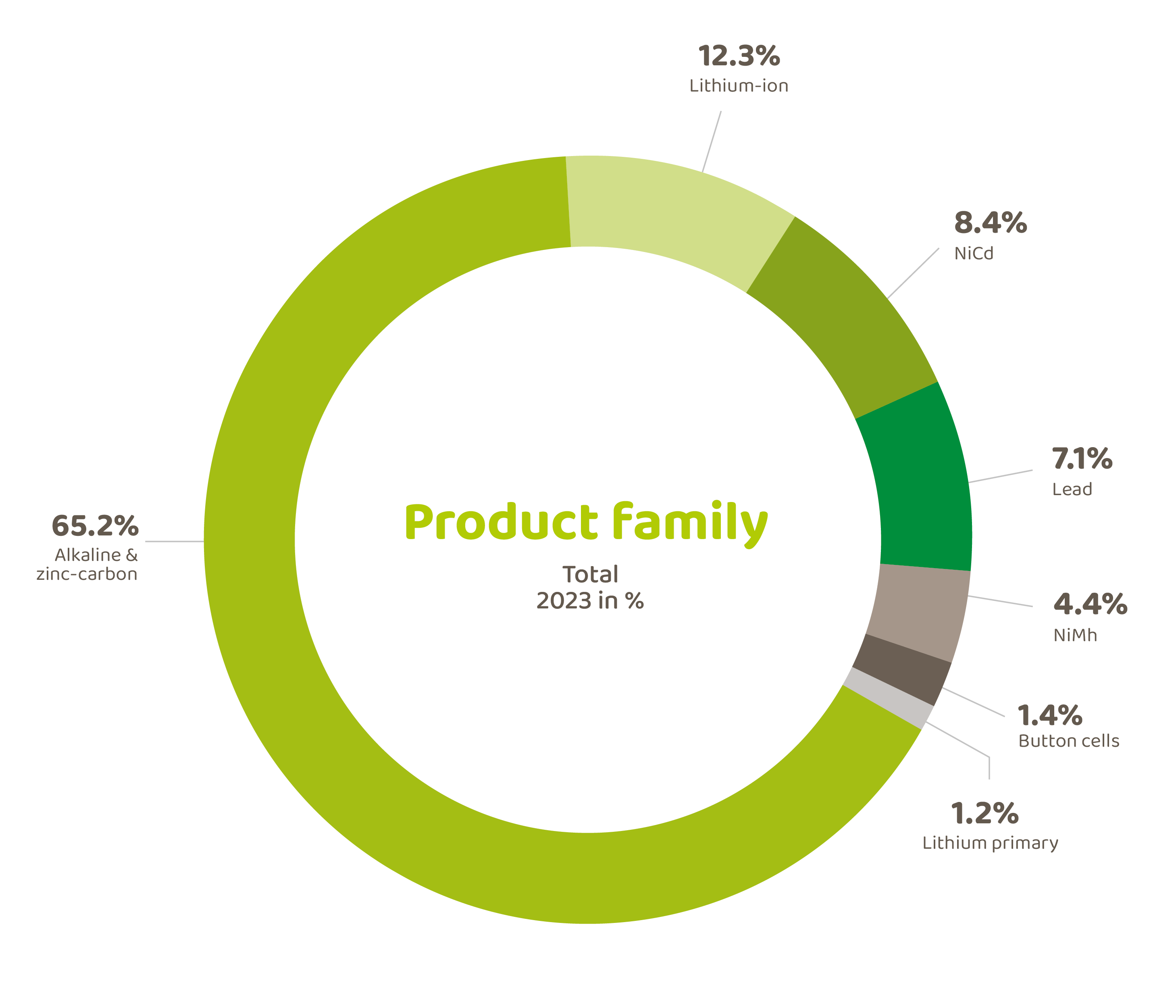
Processing plants

Recovering metals
What can we manufacture with the recovered materials?
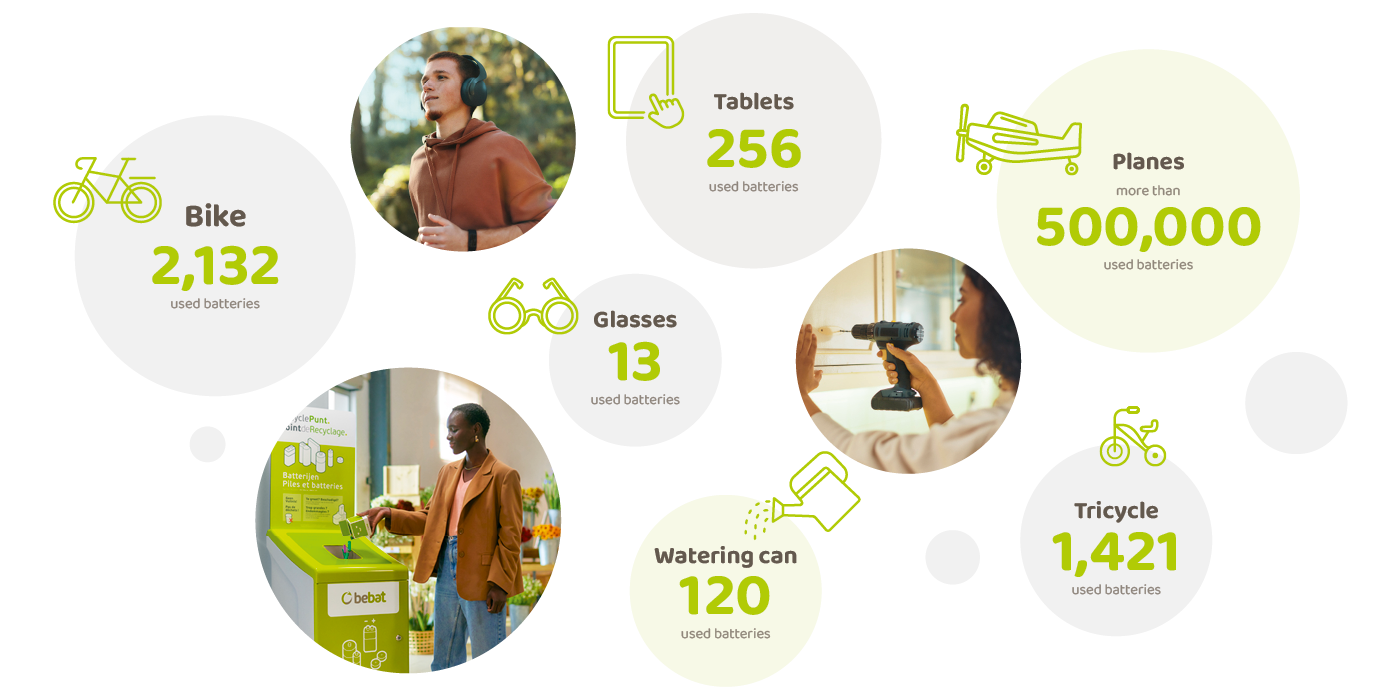
The average Belgian and batteries
-
2 to 3
The number of times a year the average Belgian hands in his batteries at a Bebat collection point. 70% of Belgians use the boxes that Bebat makes available for use.
-
131 batteries
A typical family has an average of 131 batteries in their home, of which 30 are used. (58 separate batteries and 73 in devices)
-
87%
of Belgians claims to return their batteries to a Bebat collection point. On average, Belgians store 65% of their used batteries and return them to a collection point regularly.
-
23 batteries (*)
On average, a Belgian buys 23 batteries per year. This amounts to 527 grams (*).15 batteries are bought separately in the store. The other 8 are already in a device.
(*) Portable batteries only, not including industrial batteries.
-
97%
are familiar with the Bebat system.
-
91%
know the Bebat brand as opposed to just 51% in 2010.
-
75%
consider Bebat a role model in the environmental sector.
Sources:
Bebat 2023 declarations of batteries placed on the market
N.I.S. official population figures 01/01/2023
IVOX battery study 2022
Various household waste analyses 2011-2021


